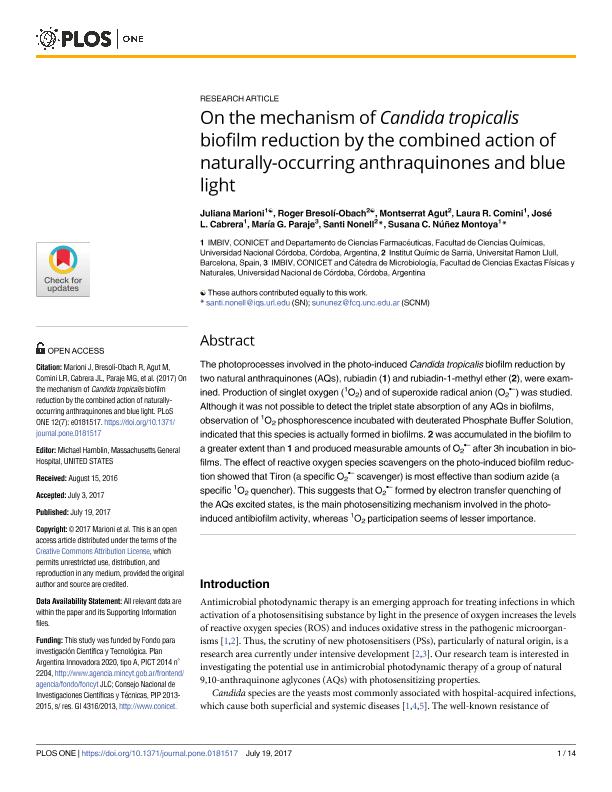Artículo
On the mechanism of Candida tropicalis biofilm reduction by the combined action of naturally-occurring anthraquinones and blue light
Marioni, Juliana ; Bresolí Obach, Roger; Agut, Montserrat; Comini, Laura Raquel
; Bresolí Obach, Roger; Agut, Montserrat; Comini, Laura Raquel ; Cabrera, Jose Luis
; Cabrera, Jose Luis ; Paraje, María Gabriela
; Paraje, María Gabriela ; Nonell, Santi; Núñez Montoya, Susana Carolina
; Nonell, Santi; Núñez Montoya, Susana Carolina
 ; Bresolí Obach, Roger; Agut, Montserrat; Comini, Laura Raquel
; Bresolí Obach, Roger; Agut, Montserrat; Comini, Laura Raquel ; Cabrera, Jose Luis
; Cabrera, Jose Luis ; Paraje, María Gabriela
; Paraje, María Gabriela ; Nonell, Santi; Núñez Montoya, Susana Carolina
; Nonell, Santi; Núñez Montoya, Susana Carolina
Fecha de publicación:
07/2017
Editorial:
Public Library of Science
Revista:
Plos One
e-ISSN:
1932-6203
Idioma:
Inglés
Tipo de recurso:
Artículo publicado
Clasificación temática:
Resumen
The photoprocesses involved in the photo-induced Candida tropicalis biofilm reduction by two natural anthraquinones (AQs), rubiadin (1) and rubiadin-1-methyl ether (2), were examined.Production of singlet oxygen (1O2) and of superoxide radical anion (O2·−) was studied. Although it was not possible to detect the triplet state absorption of any AQs in biofilms, observation of 1O2 phosphorescence incubated with deuterated Phosphate Buffer Solution, indicated that this species is actually formed in biofilms. 2 was accumulated in the biofilm to a greater extent than 1 and produced measurable amounts of O2·− after 3h incubation in biofilms.The effect of reactive oxygen species scavengers on the photo-induced biofilm reduction showed that Tiron (a specific O2 ·− scavenger) is most effective than sodium azide (a specific 1O2 quencher). This suggests that O2 ·− formed by electron transfer quenching of the AQs excited states, is the main photosensitizing mechanism involved in the photoinducedantibiofilm activity, whereas 1O2 participation seems of lesser importance.
Palabras clave:
Anthraquinone
,
Candida Biofilm
,
Singlet Oxygen
,
Photoreduction
Archivos asociados
Licencia
Identificadores
Colecciones
Articulos(IMBIV)
Articulos de INST.MULTIDISCIPL.DE BIOLOGIA VEGETAL (P)
Articulos de INST.MULTIDISCIPL.DE BIOLOGIA VEGETAL (P)
Articulos(INBIONATEC)
Articulos de INSTITUTO DE BIONANOTECNOLOGIA DEL NOA
Articulos de INSTITUTO DE BIONANOTECNOLOGIA DEL NOA
Citación
Marioni, Juliana; Bresolí Obach, Roger; Agut, Montserrat; Comini, Laura Raquel; Cabrera, Jose Luis; et al.; On the mechanism of Candida tropicalis biofilm reduction by the combined action of naturally-occurring anthraquinones and blue light; Public Library of Science; Plos One; 12; 7; 7-2017; 1-14
Compartir
Altmétricas



